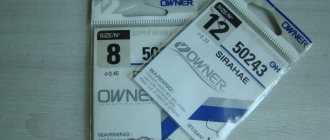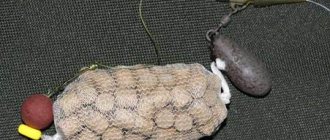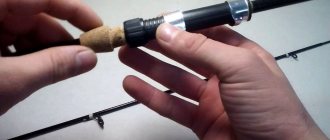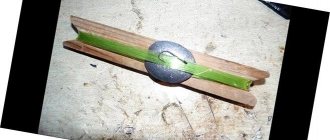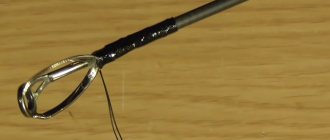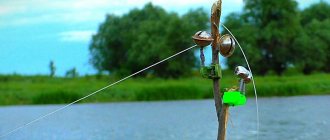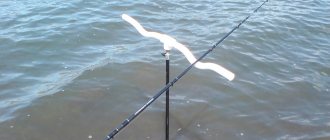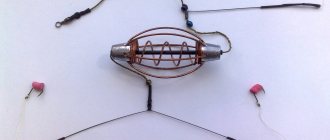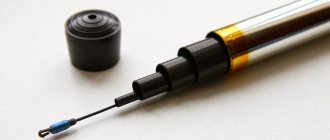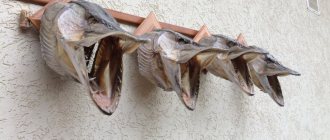Pros and cons of using gear
The advantages of bottom spinning rods are:
- Possibility to fish at great depths and at a distance from the shore (about 100m).
- The ability to combine fishing with the process of feeding.
- Possibility of fishing in reservoirs with strong currents.
- The ability to control the fishing process using a signal system in the form of sound and visual devices that respond to the slightest touch of fish to the bait.
The disadvantages of using donks include attachment to a specific area of the reservoir and labor-intensive removal of prey and all gear at the end of fishing.
Trick from a spinning rod
It is problematic to catch a large fish with a bait on a reel, but with a spinning rod the chances are much higher - we will talk about how to make a bait from a spinning rod. The question of the feasibility of making such a design does not arise: the possibilities of bottom fishing with its attachment to one point and resistance to the current are combined with the likelihood of long casting and the active response of a spinning rod to bites.
The combination of a reel bait and a spinning rod will make fishing more fun and productive. It is important that significant financial costs will not be required.
Donk equipment
Thanks to the naturalness of the baits located on the bottom and the design features of the tackle, donks are characterized by enviable catchability.
Donka consists of the following components:
Spinning rod , about 2 m long (or fishing rod). Tip: the length of the spinning rod must meet the angler’s requirements, taking into account the distance of casting the feeder from the shoreline or boat. The optimal length is about 2.5 m.

Inertia-free reel (spool size 3000). Advice: You should choose a multifunctional reel in order to prevent unforeseen situations with the main fishing object - large predatory fish.
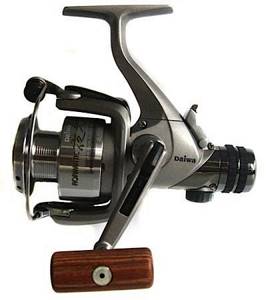
Monoline , 100m long and about 0.3mm in diameter.
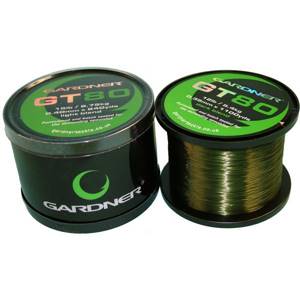
Lead line , 20 m long and about 0.2 mm in diameter.
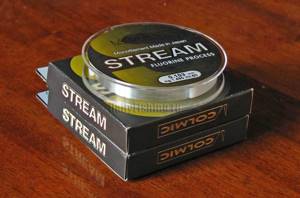
Feeder sinker , weighing 40–100 g (weight depends on the type of fish). Advice: for each reservoir, the optimal feeder is selected based on color, weight, type of bait, but it is recommended to stock up on a variety of types during fishing.
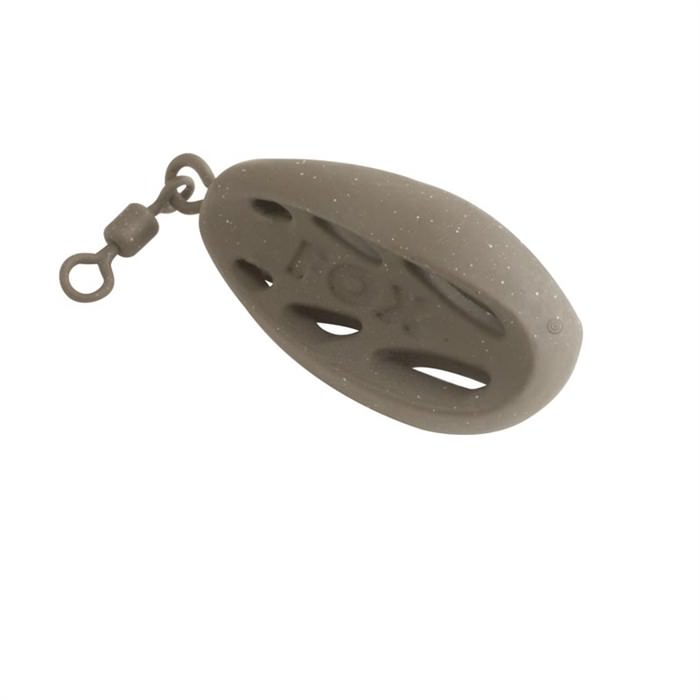
Hooks of appropriate sizes (No. 6, No. 7, No. 8). Advice: in any situation it is necessary to have a set of leashes with different sizes of hooks and thickness of fishing line, since it is impossible to predict the bite.
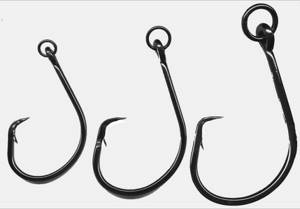
Bite alarm (electric device, bells, floats, etc.).
You can learn how to make a bite alarm with your own hands from our article.

A reliable stand for a spinning rod that can withstand jerking fish.
The number of leashes depends on the type of feeder and is standard 2–5 pieces.
Donkey device with feeder
All gear consists of the following elements:
- Spinning rod (the bigger the test, the better). Ideally, from 40 g dough. Jig rods are best suited, because they are specifically aimed at fishing with heavy jig heads.
- Inertialess reel. Any will do, since our gear is budget-friendly. If only she laid the line well. When purchasing, you can focus on standard parameters - the number of bearings (4 or more, preferably 6-8) and the quality of the housing (the more metal parts, the better, minimum metal spool).
- Fishing line – don’t go cheap here and buy high-quality monofilament fishing line that has minimal stretch when stretched. Diameter 0.3 mm. The fact is that we will have to monitor the tip of the rod, and it, in turn, gives a signal about touching the bait, but if the fishing line is too susceptible to stretching, then you will not notice the touch of the fish. There is an option with braided fishing line - it does not stretch at all, but it is less preferable due to its high cost.
- Feeder equipment is a combination of a feeder weight and a leash with a hook, which would allow all bite signals to be very sensitively transmitted to the tip of our rod. There are many different rigs. We will focus on the simplest one - paternoster. The manufacture of equipment is described in detail in our article.

Brief description of the Paternoster equipment. A loop is made on the main line, which when folded takes up a length of 20 cm. Further, 20 cm from the base of the loop, a leash made of fluorocarbon (or, less preferably, monofilament line) is attached. Leash length 1 meter. At the end of the leash there is a hook (to the size of the mouth of the intended prey, so that it can easily fit into the mouth). Let's return to the loop and use the "Cape" method to include a feeder in it.
Donkey installation
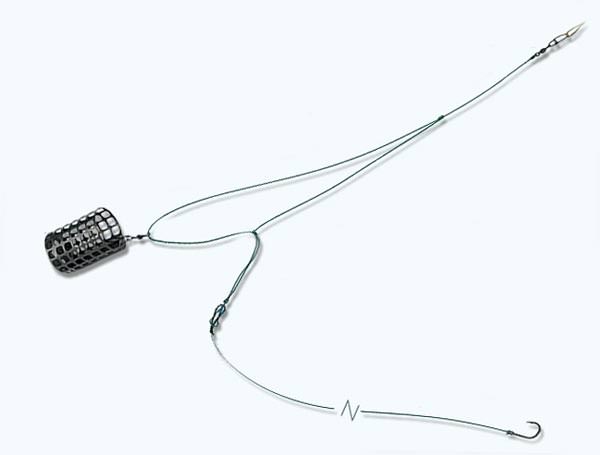
To design a donkey, you must follow the structure assembly algorithm:
- Assemble the rod and firmly secure the reel with guide rings, placing them in one row.
- Wind the fishing line onto the spool and bring it through all the rings of the rod, after which a knotted loop is formed at the very end of the fishing line.
- Drop the line guide bracket and attach the line to the spool.
- Wind the line onto the reel.
- A sinker-feeder is attached and fixed to the main fishing line, after which a second knot loop is formed at the end of the base.
- Attach one leash with a hook and additional equipment if necessary to the last knot loop.
- Install a fishing rod stand with a bite alarm.
Tip: to securely attach hooks to leashes, the most efficient way is to use knotless fasteners.
With the help of a donkey, it is possible to study a reservoir by moving along the coastal line.
Donkey fishing is carried out in several stages:
- Assembly and installation of the fishing rod.
- Casting a sinker with a feeder attachment.
- Carrying out hooking after the first bait.
- Catching fish by winding fishing line onto a reel.
Bite alarms for donkeys
Bite alarms are conditioned signals that let the fisherman know that the fish is somehow acting on the bait. Signaling devices are mechanical, light and sound.
Mechanical:
- rod nods (the line causes the end of the rod to oscillate);
- “monkey” (a weight is attached between the ring and the reel, which causes the line to sag. When biting, the line stops sagging and the weight moves);
- swinger (attached to a lever with a weight. When biting, vibrations of the rod are also noticeable).
Light signaling devices are called indicators that make it clear that there is a bite on the donk using light. Such a signaling device is attached to the tip of the rod and gives a light signal when there is a bite. Popular among night fishing enthusiasts.
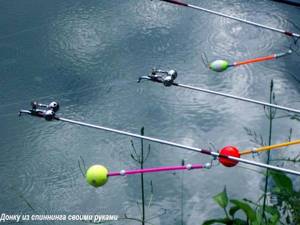
When bitten, sound alarms emit sound signals. They are also attached to the fishing rod and emit sound signals when the fishing line is pulled, which makes it clear that there is a bite.
Electronic bite alarms
Electronic bite alarms are an additional type of alarms that provide combined bite signals (light and sound). They can be attached to the tip or holder of a fishing rod and, using a special system, warn about a bite on the rod. These alarms are only common among professionals.
Feeder installation options
The options for installing feeders are very diverse, but there are several main ones:
- Installing a tube with an anti-twist.
- "Paternoster" (Gardner rig).
- Loop systems (symmetrical, asymmetrical).
- "Nipple spring."
- "Makushatnik."
Installing a tube with an anti-twist is the least complicated option for installing feeders, in which the fishing line is passed through the curved cavity of the tube and secured with a bead or other convenient method. At the bend there is a swivel with a carabiner for quick replacement of the feeder.
“Paternoster” is a popular type of installation, characterized by the formation of a loop from the main fishing line, onto which a swivel with a carabiner is first threaded to secure the feeder, and a second loop at a distance of 20-30 cm for attaching a leash. This method of equipment is relevant for standing reservoirs with a muddy bottom.
Tip: to determine the bottom topography, you should use marker floats.
The use of loop systems involves the use of loops of asymmetrical and symmetrical design, from which a knot loop is formed for mounting a leash with a swivel. Effectively used in standing reservoirs and in currents.
The installation of a “nipple spring” with its inherent placement of bait on a hook, which is swallowed by a fish, is as follows:
- A spring feeder is attached to the main fishing line, and rubber stops in the form of pellets or beads are installed.
- Fastening the leashes with hooks around the circumference of the entire spring at the same distance from each other.
- A bait attachment, the type of which is dictated by the type of fish being caught.
Fishing tackle of the “makushatnik” type is manufactured according to the following sequence of actions:
- A sinker is threaded onto a line with a diameter of 0.4–0.6 mm and secured with a knot.
- A swivel is attached to the free end of the fishing line.
- Behind the swivel, a piece of topcoat is placed, which is also secured with a knot.
- At the very end of the fishing line, a fastener with leashes is installed.
- Pressing the hooks into the above piece of topcoat.
In addition to typical variations, feeders vary in shape and weight, due to the heterogeneity of fishing conditions:
- Thus, for standing reservoirs, feeder traps (such as “paternoster” and loop systems) with a short leash and light weight are used.
- For rivers, feeders with a flat lid or in the form of a cylinder are used.
- For reservoirs with fast currents - with a rectangular lid and a relatively large weight (maximum 60 grams), which allows you to evenly scatter the food along the bottom.
- For slow-flowing reservoirs, it is optimal to use cylindrical feeders with a built-in control valve system for dosed feed supply.
- A cone feeder is suitable for lakes and deep areas, the shape and design of which is indispensable when catching large species of fish.
Tip: the most productive for any pond are flat feeders with a lot of weight.
Dropshots
A drop shot is a tackle primarily aimed at catching predators in deep places in a reservoir. It is suitable for both shore and boat fishing. Its equipment is not complicated, but it has two features: the hook is located perpendicular to the main cord, and the bait is a silicone fish or a vibrating tail made of a similar material.
IMPORTANT! Some fishermen thought of choosing and baiting not rubber, but natural live bait. If you use silicone baits, then before using them for fishing, we recommend keeping the products in water for 2 days.
How to knit a feeder on a feeder
This material has a strong odor that may arouse suspicion in aquatic life, so rinsing is highly recommended. Dropshots are equipped with an elongated sinker, which is selected in accordance with the bottom topography and the expected casting distance. Assembling such gear will not cause any trouble:
- We don’t touch the rod and reel, we leave it as is.
- We measure 30-40 centimeters from the end of the cord. We take an ordinary or offset hook and tie it using a special Palomar knot. The diagram is shown in the picture below.
- At the very end of the main line we tie a swivel with a carabiner - the load is fastened here.
- We attach a vibrating tail or fish to the hook.

The Palomar type knot is the only connection in which the hook takes a horizontal position!
That's it, it turned out to be a spinning donk of the “dropshot” type. There is no need to attach guards to the rod - the tactics are similar to ordinary spinning fishing (casting, attracting and retrieving). The fisherman will feel the bite himself when he begins to reel in the fishing line.
For peaceful fish, Siberians have come up with a modification of the drop shot, which allows them to be caught. Such tackle can also be made from a spinning rod. Instead of the Palomar knot, a leash is used. The usual bait is put on the hook: a worm, maggot, bloodworm, corn, pearl barley, and so on, depending on the target fish. This modification is used to catch bream, carp, and crucian carp. We select the hook size according to the size of the fish. The requirements for fishing lines are the same in all cases: the fisherman needs to tie the cord, judging by the body weight of the aquatic inhabitant, to which is added the force of its jerks during the bite.
Technique for fishing with a spinning rod and a feeder
When fishing for a certain type of fish with a feeder, you should take into account the underwater current, which can significantly expand the radius of passage of fish from the place where the donkey is cast. Casting is carried out taking into account the habitat of the fish species of interest. So, when fishing for bream, which prefers places far from the coastline, casting as far as possible is effective. For carp, constant bait is required in a certain place to keep it in this zone for the required time.
The following stages of fishing are distinguished:
- Preparation of bait (saturating it with moisture for 20-30 minutes).
- Carrying out depth measurements in the planned area of the reservoir.
- Starting casting of feed with a feeder.
- Donk fishing with constant bait every 10-15 minutes.
- Hatching fish immediately after starting feeding.
- Fishing.
Advice: you need to change the fishing location if the fish are not biting within the first hour after the starting cast, or change the bait.
The groundbait used for donkeys must contain a base (of plant and (or) animal origin), flavorings and aromas. Dry cereals are suitable as a base: semolina, millet, pearl barley and other plant components, viscous mixtures of which can remain at the bottom for a long time, gradually being washed away by the internal current. The bait itself must be of animal origin (selected depending on the preferences of the fish and the ability to stay on the hook): worms, leeches, etc. While playing an attractive role, the bait should not be more nutritious than the bait.
Bottom depth measurements are carried out using a marker float and sinker, which are attached to the line of a spinning reel. This type of bottom depth measurement is effective for standing reservoirs. If there is a current, you should take care of a heavier sinker and a voluminous float that can resist the current and float above the sinker for the most accurate measurements in the planned area of the reservoir.
The main role of the starting cast with a feeder is to initiate the process of feeding the selected place (about 7-20 casts with an interval of 10-15 minutes each) with a loosely filled feeder to wash out the bait more quickly, which will ensure a productive process of bottom fishing. Advice: having determined the optimal consistency of the feeding, the contents of the feeder should be enough for 10 minutes, and even less when starting casting.
After biting the bait, the fish often hook themselves onto sharp hooks with bait. Fish should be brought to the shore in a clean area of the reservoir: without vegetation and snags, where you can miss the prey and not complete the process of tiring it out. Advice: most species of fish caught on a hook are very active when they rise to the surface and can tear off the tackle, so it is recommended to pull the fish to the water’s edge and, tiring, smoothly bring it to the shore.
Bottom fishing, which does not require special attention, is very popular among amateur fishermen; moreover, fishing can be done around the clock, in any weather, both from the shore and from boats. Another advantage of using donks is that the bait can be cast over long distances and at different depths. Being located on the bottom, this type of bait looks the most natural and does not scare away the fish, which is often typical for fishing with the help of floats.
Converting a spinning rod into a donk
Sometimes a fisherman finds himself in certain circumstances when the need arises to convert his spinning tackle into a bottom one.
For example, he stopped for the night or a rest, and so that the gear did not wander, he converted it into a bottom one and caught bottom species of fish. Or a pike hunter decided to try to take a toothy one with live bait and for this he decided to convert the spinning rod into bottom tackle.
How to catch more fish?
I have been active fishing for quite some time and have found many ways to improve the bite. And here are the most effective:
- Bite activator. Attracts fish in cold and warm water with the help of pheromones included in the composition and stimulates its appetite. It’s a pity that Rosprirodnadzor wants to impose a ban on its sale.
- More sensitive gear. Reviews and instructions for other types of gear can be found on the pages of my website.
- Lures using pheromones.
You can get the rest of the secrets of successful fishing for free by reading our other articles on the site.
Installation of hooks
| Type of fish | Line diameter | Hook No. |
| Bream, Ide | 0,25-0,3 | 6,7,8 |
| Podlesch, silver bream | 0,18-0,2 | 5,6 |
| Som | 0,4 | 10,11,12,13,14 |
| Pike | steel leash | 10, double |
| Zander | 0,35 | 10 |
One of the decisive elements of bottom tackle is the leash. It is a piece of fishing line to which a hook is attached on one side and a loop is tied on the other. The success of all bottom fishing depends on how correctly it is made. The diameter of the fishing line on the leash, as well as the length of the leash and the hook number must exactly match the intended type of fish caught.
Installation of the feeder
After a decision has been made about what kind of fish the fisherman plans to catch and a leash has been made, it is necessary to select a specific installation of a feeder or sinker.
It makes sense to place a feeder only for white species of fish: bream, ide, silver bream, roach, etc., but for predatory fish it is advisable to use a sinker.
There are several types of equipment that can be used when converting a spinning rod into a donkey:
- equipment with anti-twist;

- paternoster;

- symmetrical loop;
- asymmetrical loop.
The simplest and most frequently used are equipment with an anti-twist and a paternoster. Methods for their manufacture are shown in the pictures.
Symmetrical and asymmetrical loops are heavier to manufacture and are usually used in feeder fishing. Therefore, their use when converting a spinning rod into bottom tackle will not be advisable.
Fishing Features
The main obstacle or limiter for converting a spinning rod into a donkey is the spinning rod test. Typically, the upper test of a standard spinning rod is about 40 grams. But for bottom gear, this weight limit is very low. Therefore, you have to slightly overload the device up to 60 grams. In this case, casting the tackle must be done smoothly and over a short distance.
Converting a spinning rod into a donk is one of the possible options to save spinning fishing when a predator refuses to take absolutely all the bait. In order to stay with the catch, the fisherman sometimes uses a variety of different non-standard approaches. And the conversion of a spinning rod into a donk is just one of these transformations that increases the overall result of the hunt.
Blitztips
- Advice: when fishing using feeders, the bait must be higher in taste than groundbait, which underlies the catchability of the gear.
- Tip: in order for the line to withstand the load when casting the feeder, you need the correct ratio of the radius of the line and the weight of the feeder sinker. To maintain balance, it is enough to insert a thicker thread of fishing line, about 5-10 cm long. This auxiliary part is also called a shock leader.
- Tip: when fishing with a spinning rod with a feeder, it is very important to stock up on sharp hooks to quickly hook fish while feeding.
- Advice: for fishing, it would be useful to have backup sets of hooks, feeders, sinkers, and spools of fishing line of different sizes, weights and diameters, respectively, which will prevent disruption of the fish hunt.
- Tip: experienced fishermen make successful hookings by carefully monitoring the nature of the oscillatory movements of the built-in signaling system: the slightest change in rhythm is a signal for immediate action.
Requirements for the rod
A do-it-yourself spinning rod cannot be made from any fishing rod. Many options are in no way suitable for this method of fishing. Ultralight blanks, as well as trout rods, the test of which rarely exceeds 5 grams, definitely should not be converted into donks, even though most often these are the spinning rods that have the most sensitive tips.
For use as a donkey, rods with a certain safety margin and a test weight of 40 grams and above are more suitable. Although there is no need to talk about the high sensitivity of such gear, they are at least capable of working with feeders or sinkers of sufficient mass for comfortable fishing. The preferred action is fast or closer to medium, although slow forms can also be used.
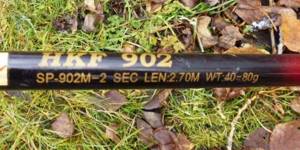
Photo 1. Powerful rod.
Separately, it is worth mentioning cheap Chinese fishing rods. They cope quite well with both bottom and spinning fishing, but with a number of reservations. Firstly, you should not use cords with them - the braided line quickly damages the inserts of the guide rings. Secondly, the quality of such a product is an unpredictable lottery; such a rod can break on the very first fishing trip, or it can last for years. Thirdly, the sensitivity of the tips of such products is worse than ever.

Photo 2. General view of the donkey.
Important! Although it is not recommended to exceed the rod test, it is still possible. The main thing is not to try to make power casts and not to overload the rod too often.
Feeders and bait
On the question of which spinning rod is best for donkeys, feeders don’t have the last word. Casting a spinning rod with a light mesh model is one thing, and quite another with a heavy “method”. Naturally, when using a heavy load, it is advisable to have a higher test form.
If the method feeder and killer springs are mainly filled with porridge, then feeder models are used with bulk bait mixtures. Some fishermen make up such baits themselves, others use branded ones from the store.

